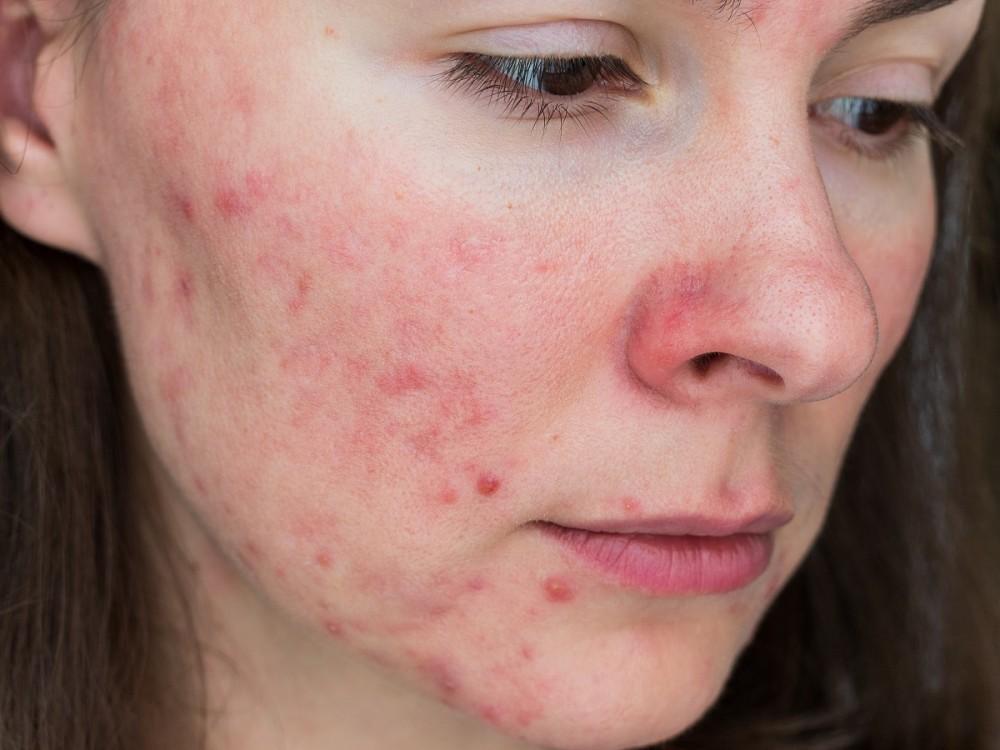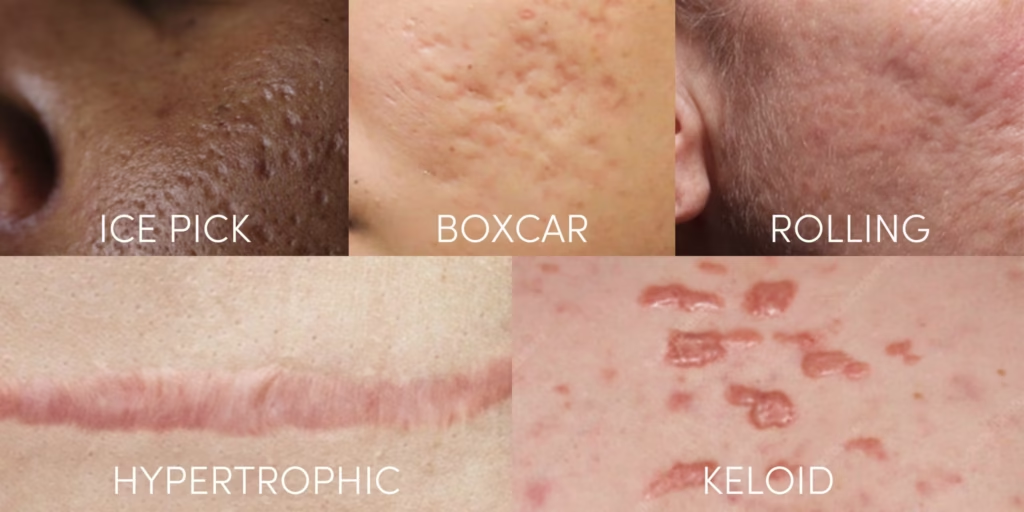Living with acne scars presents a unique challenge: not only are you working to improve the appearance of existing scars, but you’re also trying to prevent new breakouts that could create additional scarring.
This comprehensive guide will help you navigate this delicate balance with effective, science-backed strategies.
Understanding the Connection Between Acne Scars and New Breakouts

Acne scarring occurs when the body’s natural healing process after a breakout doesn’t go perfectly. When follicle walls break during severe inflammation, infected material can spill into the dermis, destroying healthy skin tissue.
Your body creates new collagen fibers to repair this damage, but the finished result often has a different texture and appearance than your original skin.
Scarred skin is more vulnerable to new breakouts for several reasons:
You might be interested: INFINI RF Microneedling: Treat Your Acne Scars
Compromised barrier function: Scar tissue often has an altered structure that doesn’t protect as effectively against bacteria and environmental irritants
Irregular oil distribution: Scars can disrupt normal sebum flow, creating areas of excessive oiliness
Impaired cell turnover: Scarred areas may not shed dead skin cells efficiently, leading to clogged pores
Persistent inflammation: Many people with acne scarring have underlying inflammatory processes that contribute to both scarring and new breakouts
Types of Acne Scars and Their Specific Challenges

Different types of acne scars present distinct challenges when preventing breakouts:
You might like: The Ultimate Guide to Acne Removal in Singapore
Atrophic Scars (Depressed Scars)
- Narrow, deep punctures extending into the dermis
- Can trap oil and debris, becoming sites for new infections
- Require specialized care to prevent bacterial colonization
- Create uneven skin texture with waves and dips
- May collect product residue and dead skin cells
- Need targeted exfoliation techniques
- Broad depressions with defined edges
- Can create shadowed areas where bacteria thrive
- Benefit from strategic product application
You might like: FAQs About Acne Scar Treatments In Singapore
Hypertrophic and Keloid Scars (Raised Scars)
- Raised areas of excess collagen
- Often produce more oil than surrounding skin
- May trap bacteria and dead cells along their raised edges
- Require gentle cleansing to prevent irritation
Essential Prevention Strategies for Acne-Prone Scarred Skin

Develop a Consistent Cleansing Regimen
Cleansing is your first defense against new breakouts, but requires special consideration for scarred skin:
Morning cleanse: Use a gentle, non-stripping cleanser to remove overnight oil buildup without disrupting your skin barrier
Evening double cleanse: First remove makeup/sunscreen with a micellar water or cleansing oil, then follow with a water-based cleanser
Water temperature: Lukewarm is ideal; hot water can trigger inflammation and oil production
Application technique: Use fingertips to massage cleanser in circular motions, paying special attention to indented scars where debris can collect
Drying method: Pat (don’t rub) with a clean microfiber towel or cotton pad
This might help: Which Acne Scar Treatment Clinic in Singapore Should You Consider? (Sort by Reviews)
Products to consider:
- Cleansers with ceramides to support barrier repair
- Sulfate-free formulations that won’t strip natural oils
- Cleansers with 2% salicylic acid (1-2 times weekly) to dissolve oil in scarred areas
Master Strategic Exfoliation
Exfoliation is crucial for preventing the buildup that leads to breakouts, but requires precision on scarred skin:
| Exfoliation Method | Benefits for Scarred Skin | Best Practices |
|---|---|---|
| Chemical (AHAs/BHAs) | Dissolves connections between dead cells; penetrates into scars | Start with low concentrations (2-5%); apply with cotton pad to ensure even distribution |
| Enzyme exfoliants | Gentler option that digests surface cells | Ideal for sensitive or recently treated scarred skin |
| Physical exfoliation | Can help smooth raised scars when used judiciously | Avoid harsh scrubs; use only fine, round particles with minimal pressure |
Important considerations:
Begin with once-weekly exfoliation, gradually increasing to 2-3 times weekly as tolerated. Always follow with hydration and barrier-supporting ingredients.
Discontinue if irritation occurs and avoid exfoliating active breakouts or recently formed scars.
Balance Hydration and Oil Control
Acne-scarred skin often struggles with simultaneous dehydration and oiliness. Addressing both issues:
Hydration strategies:
Effective hydration involves layering lightweight hydrating products rather than using one heavy cream that might clog pores.
Apply hyaluronic acid serums to damp skin to maximize moisture retention and consider humectants like glycerin and sodium PCA to draw moisture into the skin.
Look for products with ceramides to repair barrier function and strengthen the skin’s natural protective layer.
You might like: Best Acne Scar Treatment Clinic in JB for Singaporeans
Oil-control approaches:
Managing excess oil production requires strategic ingredient selection and application techniques.
Use niacinamide (vitamin B3) to regulate sebum production and consider oil-absorbing ingredients like kaolin clay in problem areas where oiliness is most pronounced.
Apply hydrating products evenly across scarred regions to prevent uneven moisture distribution, and use blotting papers during the day rather than washing repeatedly, which can strip the skin and trigger increased oil production.
Incorporate Active Ingredients Strategically
Certain active ingredients can prevent breakouts while supporting scar healing:
Retinoids
Retinoids normalize cell turnover to prevent clogged pores while stimulating collagen production to improve scar appearance.
Start with adapalene (0.1%) or low-concentration retinol (0.25-0.5%) to minimize irritation during the initial adjustment period.
Apply 2-3 times weekly, gradually increasing frequency as your skin tolerates the treatment. Always pair retinoid use with sufficient moisturizer and sunscreen to prevent dryness and photosensitivity.
Related article: The Ultimate Guide to Acne Treatments in Singapore
Niacinamide
This versatile ingredient regulates sebum production, reduces inflammation, and supports barrier function repair.
It’s safe to use at 5% concentration for most skin types and can be applied both morning and evening without causing irritation or sensitivity in most users.
Azelaic Acid
Azelaic acid provides antimicrobial properties that fight acne-causing bacteria while reducing inflammation and helping fade post-inflammatory hyperpigmentation.
It’s available in 10-20% formulations and is generally well-tolerated by sensitive skin types.
Vitamin C
This powerful antioxidant provides protection against environmental damage while supporting collagen synthesis for scar improvement.
Vitamin C brightens post-inflammatory hyperpigmentation and helps create a more even skin tone. Use L-ascorbic acid formulations at 10-15% concentration in the morning for optimal antioxidant protection.
You might like: Laser Skin Pigmentation Treatment in Singapore
Prioritize Sun Protection
Sun exposure can worsen both acne and scarring through several mechanisms that compromise skin health.
UV radiation increases inflammation in already compromised skin, heat stimulates oil production that can clog pores, sun exposure darkens post-inflammatory hyperpigmentation making scars more visible, and UV damage slows the natural scar healing process.
Effective sun protection for acne-scarred skin:
Use broad-spectrum SPF 30-50 daily, even when staying indoors, as UV rays can penetrate windows.
Choose oil-free, non-comedogenic formulations specifically designed for acne-prone skin. Consider mineral (physical) sunscreens containing zinc oxide or titanium dioxide if chemical filters cause irritation or breakouts.
Apply at least ¼ teaspoon of sunscreen for the face alone to ensure adequate coverage.
Reapply every two hours when outdoors or after swimming or sweating. Supplement sun protection with protective clothing, wide-brimmed hats, and seeking shade during peak UV hours.
Break Harmful Habits
Several common habits can trigger breakouts on acne-scarred skin:
Picking and squeezing
These behaviors introduce bacteria into vulnerable scarred areas and trigger inflammation that can worsen existing scars.
Picking prolongs healing time and can create new scars in previously unaffected areas. The temporary satisfaction of removing a blemish often leads to longer-term skin damage and more visible scarring.
Excessive touching
Frequent face touching transfers bacteria from hands to face and distributes oils and products unevenly across the skin surface.
This habit can also irritate sensitive scarred skin and introduce contaminants that clog pores and trigger new breakouts.
Using dirty accessories
Maintaining clean accessories that come into contact with your face is essential for preventing bacterial transfer.
Change pillowcases weekly, clean phone screens daily with appropriate sanitizing wipes, wash makeup brushes weekly with gentle cleansers, and use fresh towels regularly rather than reusing the same towel multiple times.
Professional Treatments for Breakout Prevention and Scar Improvement
Combining home care with professional treatments often yields the best results:
Breakout Prevention Treatments
Chemical Peels
Chemical peels using superficial formulations with 15-20% glycolic or salicylic acid help prevent clogged pores and maintain clear skin. Medium-depth peels can address both acne and mild scarring simultaneously.
These treatments should be scheduled every 4-6 weeks during acne-prone periods for optimal maintenance.
Photodynamic therapy combines blue light that targets acne-causing bacteria with red light that reduces inflammation.
This dual-approach treatment typically requires 4-6 weekly sessions to achieve significant improvement in breakout frequency and severity.
Prescription medications may include topical antibiotics for bacterial involvement, specialized retinoid formulations stronger than over-the-counter options, and hormonal treatments for cycle-related breakouts that occur predictably with menstrual cycles.
Scar Improvement Treatments
Microneedling
Microneedling creates controlled micro-injuries to stimulate collagen production while improving product penetration into deeper skin layers.
This treatment helps break up scar tissue and encourages the formation of new, healthy skin cells to replace damaged tissue.
Laser Resurfacing
Laser resurfacing offers different approaches depending on the severity of scarring. Ablative lasers remove damaged skin layers entirely, while non-ablative lasers stimulate collagen production without surface disruption.
Fractional lasers treat small portions of skin at a time, allowing for faster healing and reduced downtime.
Dermal Fillers
Dermal fillers provide immediate improvement by temporarily filling depressed scars while stimulating natural collagen production in the treated areas.
Results typically last 6-18 months depending on the specific product used and individual healing response.
Creating a Customized Skincare Routine
Your ideal routine should address both breakout prevention and scar management:
Morning Routine Example
- Gentle cleanser with ceramides and antioxidants
- Antioxidant serum with vitamin C and vitamin E
- Hydrating serum with hyaluronic acid or glycerin
- Oil-control treatment with niacinamide
- Lightweight moisturizer with ceramides
- Broad-spectrum sunscreen (mineral-based if possible)
Evening Routine Example
- Makeup remover (if needed)
- Gentle cleanser
- Treatment product (rotate between):
- Retinoid (2-3 times weekly)
- Chemical exfoliant (2 times weekly)
- Azelaic acid (2 times weekly)
- Hydrating serum
- Barrier repair moisturizer with ceramides and peptides
- Occlusive product on very dry or scarred areas (optional)
Weekly Add-ons
- Enzyme mask for gentle exfoliation
- Hydrating mask with calming ingredients
- Clay mask only on oily areas
Lifestyle Factors That Impact Breakouts on Scarred Skin
Nutrition Considerations
While diet affects everyone differently, these patterns are common:
Potentially beneficial:
- Omega-3 fatty acids (salmon, walnuts, flaxseed)
- Antioxidant-rich fruits and vegetables
- Zinc-containing foods (pumpkin seeds, legumes)
- Probiotics for gut-skin connection
Commonly problematic:
- High-glycemic foods that spike blood sugar
- Dairy products (especially skim milk)
- Whey protein supplements
- Highly processed foods
Stress Management
Stress hormones can trigger both breakouts and inflammation that worsens scars:
- Practice regular stress-reduction techniques
- Consider adaptogens like ashwagandha if appropriate
- Ensure adequate sleep (7-9 hours nightly)
- Exercise moderately (excessive exercise can sometimes worsen acne)
Environmental Factors
Pay attention to these often-overlooked triggers:
- Humidity levels (too high can increase oil production)
- Harsh weather conditions
- Pollutants that clog pores
- Fabric choices (cotton or silk pillowcases preferred)
Tracking Your Progress
Maintaining a skin journal can reveal patterns and improve results:
Track daily:
- Products used
- New breakouts (location and type)
- Stress levels
- Menstrual cycle (if relevant)
- Diet highlights
Weekly assessments:
- Overall skin condition
- Progress of existing scars
- Effectiveness of current routine
- Potential triggers identified
Frequently Asked Questions
How long does it take to see results when preventing breakouts on scarred skin?
With consistent care, you can expect initial improvements in breakout frequency within 4-6 weeks. This timeline aligns with your skin’s natural renewal cycle.
More significant changes in skin texture and scar appearance typically take 3-6 months of dedicated treatment.
Be patient and consistent, as premature routine changes can delay progress. Document your journey with photos taken in the same lighting every 4 weeks to track subtle improvements that might not be noticeable day-to-day.
Can I use makeup on acne-scarred skin without causing more breakouts?
Yes, but product selection and application techniques are crucial. Choose non-comedogenic, oil-free foundations and concealers specifically formulated for acne-prone skin.
Mineral-based products tend to be less irritating and provide good coverage for discoloration. Always apply with clean brushes or sponges, and remove thoroughly at the end of the day with a proper double-cleansing method.
Consider using color-correcting products underneath foundation to neutralize discoloration without needing heavy coverage.
Should my skincare routine change during active breakouts versus maintenance periods?
During active breakouts, pivot to a more antimicrobial and anti-inflammatory approach. Increase the frequency of salicylic acid treatment, introduce benzoyl peroxide spot treatments, and reduce potential irritants like exfoliants and high-concentration retinoids.
Focus on gentle hydration and barrier support. Once breakouts resolve, gradually reintroduce your scar-focused treatments while maintaining preventative measures.
This rhythmic approach allows your skin to heal without sacrificing long-term progress on scar reduction.
Is it possible to completely prevent breakouts on scarred skin?
While complete elimination of breakouts may not be realistic for everyone, significant reduction is achievable.
Success depends on identifying your specific triggers, maintaining consistent preventative care, and addressing hormonal or internal factors that contribute to breakouts.
Many people can reduce breakout frequency by 80-90% with the right combination of treatments. Focus on progress rather than perfection, and remember that even occasional breakouts can be managed quickly with the right approach to minimize their impact.
How does hormonal acne affect scarred skin differently?
Hormonal acne tends to create deeper, more inflammatory lesions that have a higher scarring potential.
On already scarred skin, hormonal breakouts often appear in the same locations as previous scarring, as these areas may have altered oil gland activity.
Managing hormonal acne on scarred skin requires addressing both the internal hormonal triggers (through diet, stress management, or medical treatments) and the external skin barrier dysfunction.
Ingredients like niacinamide, green tea extract, and zinc can help moderate the skin’s response to hormonal fluctuations.
Can professional treatments make a significant difference in preventing breakouts on scarred skin?
Professional treatments can be game-changers for many people with acne-scarred skin.
They can address underlying issues that home care cannot reach, such as deep scar tissue that disrupts oil flow or persistent bacterial colonization.
Chemical peels, specialized facials, laser treatments, and prescription medications can work synergistically with home care to break the cycle of breakouts and scarring.
The key is finding the right professional who understands the connection between acne prevention and scar management rather than treating them as separate concerns.
What’s the relationship between diet and breakouts on scarred skin?
The diet-acne connection is highly individualized, but certain patterns emerge frequently.
High-glycemic foods that spike blood sugar can trigger increased oil production and inflammation, potentially worsening both breakouts and scar appearance.
Dairy products contain hormonal components that may influence acne in sensitive individuals. Keeping a detailed food journal alongside your skin tracking can help identify your personal triggers.
Focus on anti-inflammatory foods rich in antioxidants, omega-3 fatty acids, and zinc to support skin healing and barrier function.
How should products be applied differently on scarred versus non-scarred skin?
Application techniques matter significantly on scarred skin. For depressed scars, use gentle pressing motions to ensure products reach the base of the scar.
For raised scars, apply products with light, downward strokes to avoid product buildup around edges.
When applying active treatments, consider using a precision applicator to target scarred areas with stronger concentrations while using milder formulations on non-scarred skin.
Always ensure even distribution of sunscreen across all skin texture variations, as uneven application can lead to uneven pigmentation that emphasizes scars.
What should I do if I experience a breakout despite prevention efforts?
Address new breakouts promptly but gently to minimize scarring risk. Apply a non-drying spot treatment containing ingredients like salicylic acid, niacinamide, or sulfur rather than harsh, drying formulations.
Avoid picking or squeezing at all costs. Continue your regular cleansing routine but temporarily simplify other steps, removing any potentially irritating actives from the affected area.
If the breakout is significant or painful, consult your dermatologist promptly, as early intervention can prevent scarring.
Can over-treating skin lead to more breakouts on scarred areas?
Absolutely. The “more is better” approach often backfires with acne-scarred skin. Excessive exfoliation, too many active ingredients, or aggressive treatments can compromise your skin barrier, leading to increased oil production, inflammation, and vulnerability to bacteria.
Signs of over-treatment include persistent redness, sensitivity, tightness, and paradoxical oiliness. If you notice these symptoms, immediately scale back to a minimal routine focused on gentle cleansing, simple hydration, and barrier repair for at least two weeks before gradually reintroducing active treatments.
Conclusion
Managing acne-prone, scarred skin requires patience, consistency, and a strategic approach that addresses both concerns simultaneously. By understanding the unique challenges of your scarred skin and implementing the comprehensive strategies outlined in this guide, you can significantly reduce breakout frequency while supporting your skin’s healing process.
Remember that progress may be gradual, but with persistence and the right combination of home care, professional treatments, and lifestyle adjustments, clearer skin with improved texture is achievable.

